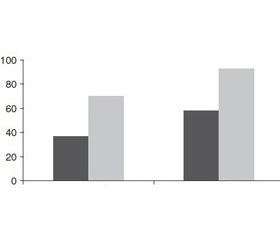Журнал «Медицина неотложных состояний» 4 (83) 2017
Вернуться к номеру
Використання симуляційних технологій для формування компетентності клінічних ординаторів і аспірантів у проведенні серцево-легеневої реанімації
Авторы: Дацюк О.І.(1, 2), Очеретна О.Л.(1), Бевз Г.В.(1), Дацюк Л.В.(3), Озимий В.А.(4)
(1) — Вінницький національний медичний університет імені М.І. Пирогова, м. Вінниця, Україна
(2) — Вінницька обласна клінічна лікарня ім. М.І. Пирогова, м. Вінниця, Україна
(3) — Вінницький обласний клінічний онкологічний диспансер, м. Вінниця, Україна
(4) — Українська військово-медична академія, м. Київ, Україна
Рубрики: Медицина неотложных состояний
Разделы: Клинические исследования
Версия для печати
Мета роботи — оцінка ефективності симуляційних технологій у процесі формування та підтримання у клінічних ординаторів і аспірантів практичних навичок серцево-легеневої реанімації та компетенцій надання невідкладної допомоги. Здійснено проспективний аналіз навчання та засвоєння теоретичних знань і практичних навиків із проведення серцево-легеневої реанімації клінічними ординаторами та аспірантами. Встановлено, що симуляційні форми навчання з використанням сучасних манекенів сприяють швидкому, ефективному та безпечному формуванню в слухачів курсу як технічних, так і нетехнічних навичок надання невідкладної допомоги.
Цель работы — оценка эффективности симуляционных технологий в процессе формирования и поддержания у клинических ординаторов и аспирантов практических навыков сердечно-легочной реанимации и компетенций оказания неотложной помощи. Проведен проспективный анализ обучения и усвоения теоретических знаний и практических навыков по проведению сердечно-легочной реанимации клиническими ординаторами и аспирантами. Установлено, что симуляционные формы обучения с использованием современных манекенов способствуют быстрому, эффективному и безопасному формированию у слушателей курса как технических, так и нетехнических навыков оказания неотложной помощи.
Background. Simulation in medical education is a modern teaching method based on realistic modeling, and imitation of clinical situation or particular physiological system, and can be used for evaluation of practical skills, abilities and knowledge. Biological, mechanical, electronic and virtual/computer models may be applied for this purpose. Nowadays, simulation is one of the most effective ways to reduce the incidence of complications and mortality. This technique allows to acquire clinical practical skills and to improve teamwork cooperation (non-technical skills) due to work on simulators. Evaluating the effectiveness of simulation technology in education and maintenance of practical skills in cardiopulmonary resuscitation (CPR) and the first aid competence among clinical residents and post-graduate students was the purpose of our study. Materials and methods. Prospective analyses of CPR learning, memorization of theoretical knowledge and practical skills were conducted among clinical residents and post-graduate students by the educational and training center of Vinnytsia National Medical University. 243 clinical residents and post-graduate students of their first year (2014–2016 years) took part in the research. The average age of students is 30.2 ± 1.4 years. Six-hour simulation training course was carried out in the groups of 6–8 people. Seven-stage simulation training course included: primary evaluation of knowledge (pre-test); briefing; simulation training; debriefing (analysis of an educational process, including the series of questions asked by a teacher); final test (post-test); summarizing; anonymous questionnaires. During the training, there were used II–III realistic level dummies, original chambers of intensive therapy, as well as tools and supplies. Attitude/behavior was assessed by the questionnaire. A test control was used to check the qualifications of clinical residents and post-graduate students, i.e. pre-tests were compared with the results of the final tests. A checklist was used to estimate the clinical residents’ and graduate students’ CPR skills, and to correct the implementation of the basic algorithm. The checklist included: check of consciousness, carotid pulse, CPR start with chest compressions (C-A-B algorithm), restoration of breathing, ventilation and compression ratio (30 : 2), etc. Attitude/behavior assessment was conducted by the questionnaire. Excel and statistical data were processed using SPSS 13 (©SPSS Inc.) for statistical data processing. Results. Basic and final theoretical levels were compared, and the following information was received: an average score for basic knowledge (pre-test) was — 4.30 ± 1.81, the final test (post-test) showed 10.78 ± 1.64. The survey results indicate that the final assessment of knowledge among students who participated in the training simulation (p < 0.001) showed a significant increase by 2.5 times compared to their basic level. As a result of detecting the basic practical skills level to provide intensive care among residents and post-graduate students, the following data arouse: the average score for conducting artificial respiration after the lecture and practical skills increased by 22 %, for conducting indirect heart massage — by 25 % (p < 0.05). Checklists results analysis shows that the most frequent errors during CPR are as follows: low frequency of chest compression per minute (58 %), long intervals between chest compression and ventilation (22.2 %), failure of chest compression/ventilation ratio (25.1% ), incorrect support of respiratory tract (37.9 %), high frequency ventilation (50.6 %). Conclusions. Using CPR simulation technologies in practice helps objectively evaluate basic professional qualification, quickly accumulate practical skills, and raise the level of competence. Simulation technology in the frame of practical courses emphasizes the importance of the ability to work in a team.
серцево-легенева реанімація; симуляційний тренінг
сердечно-легочная реанимация; симуляционный тренинг
cardiopulmonary resuscitation; simulation training


/32-1.jpg)